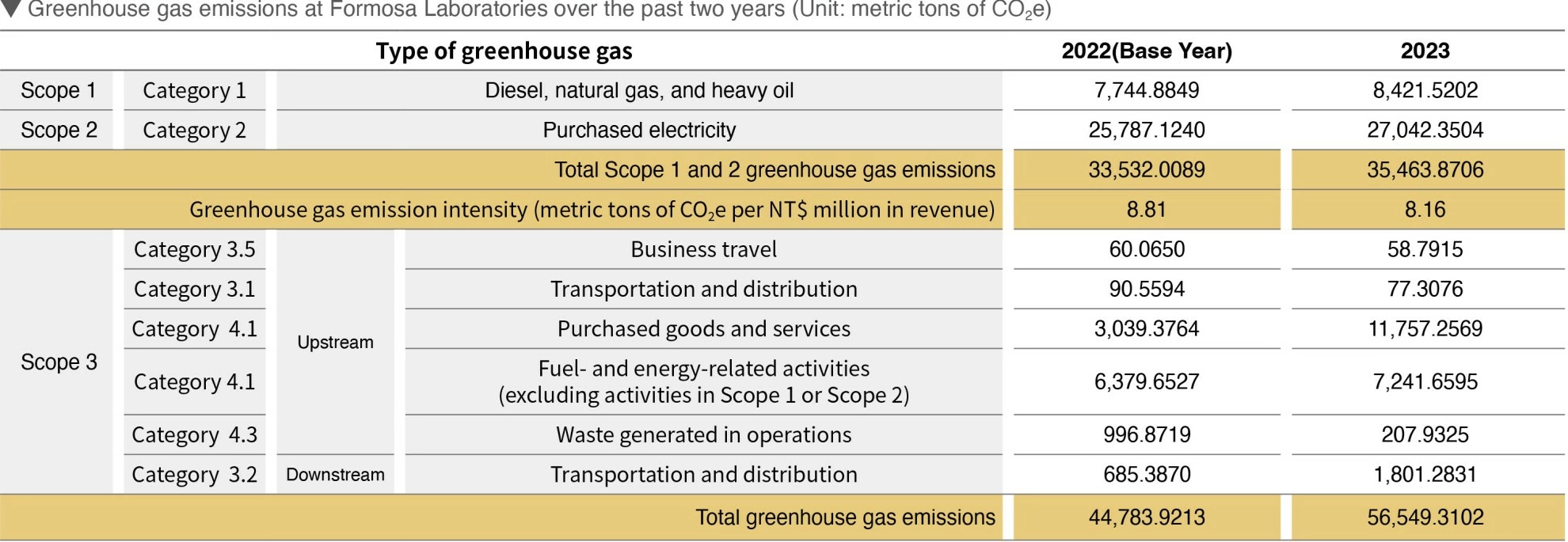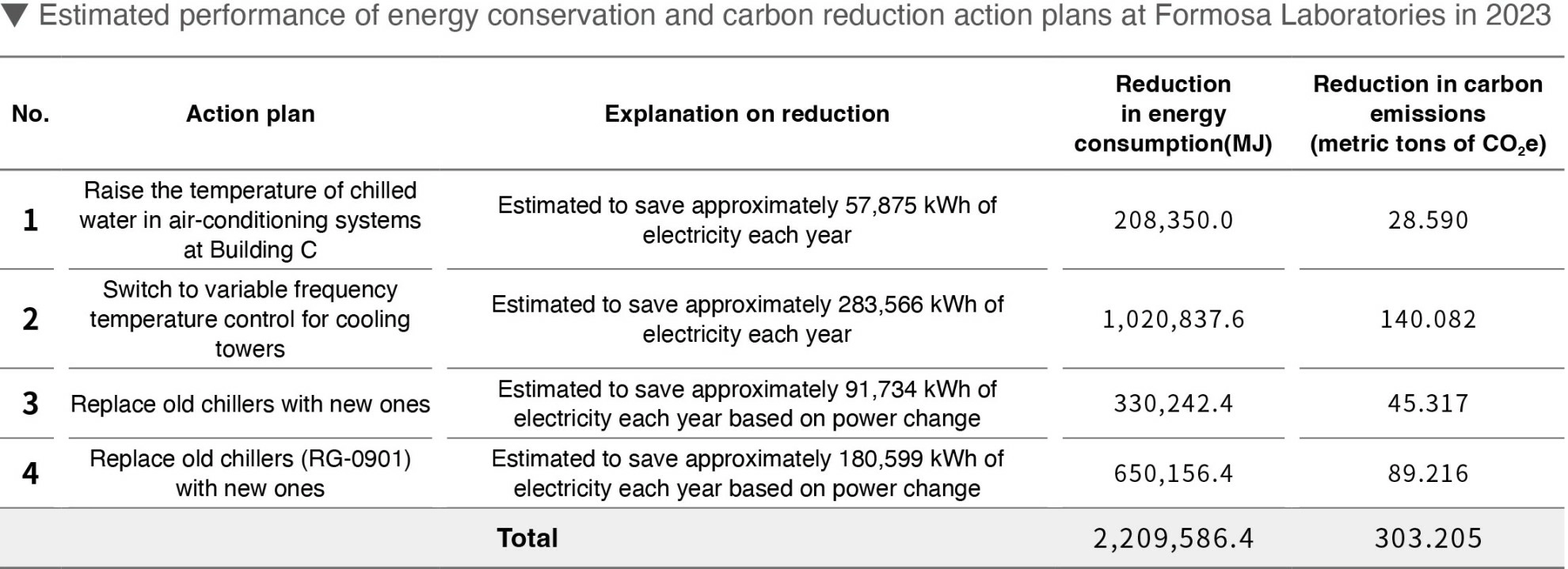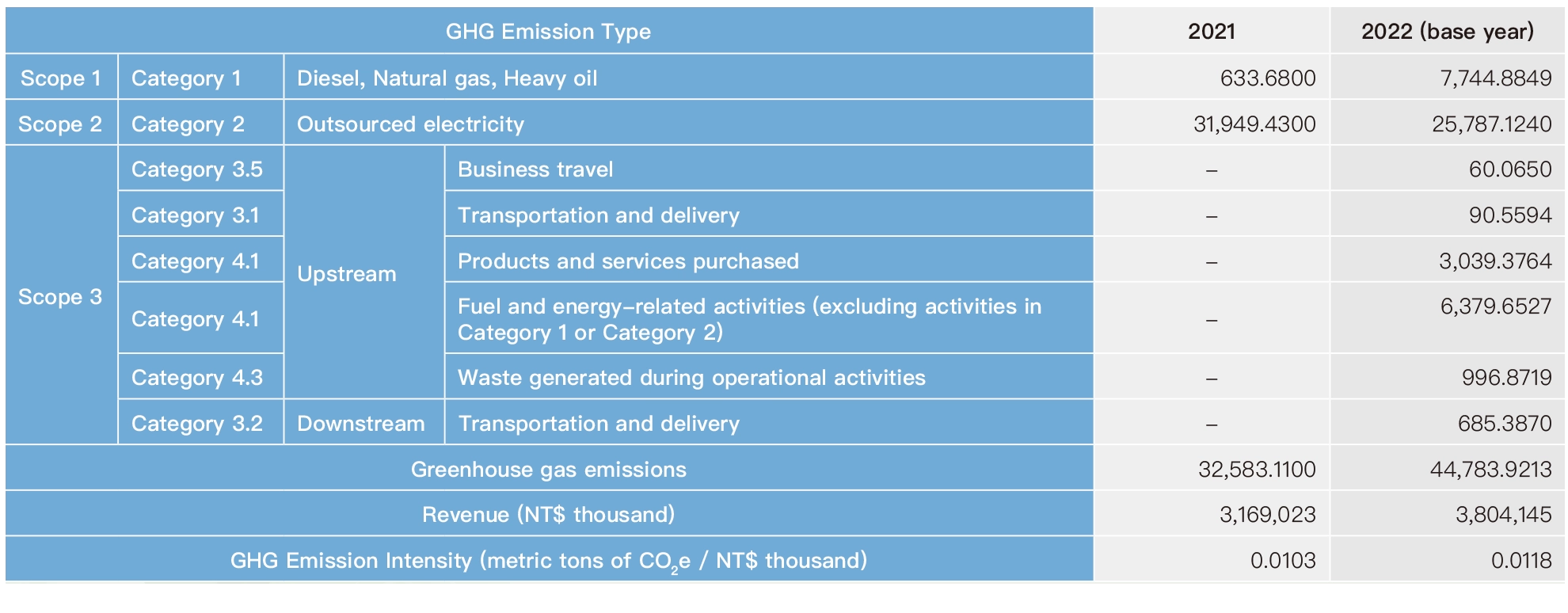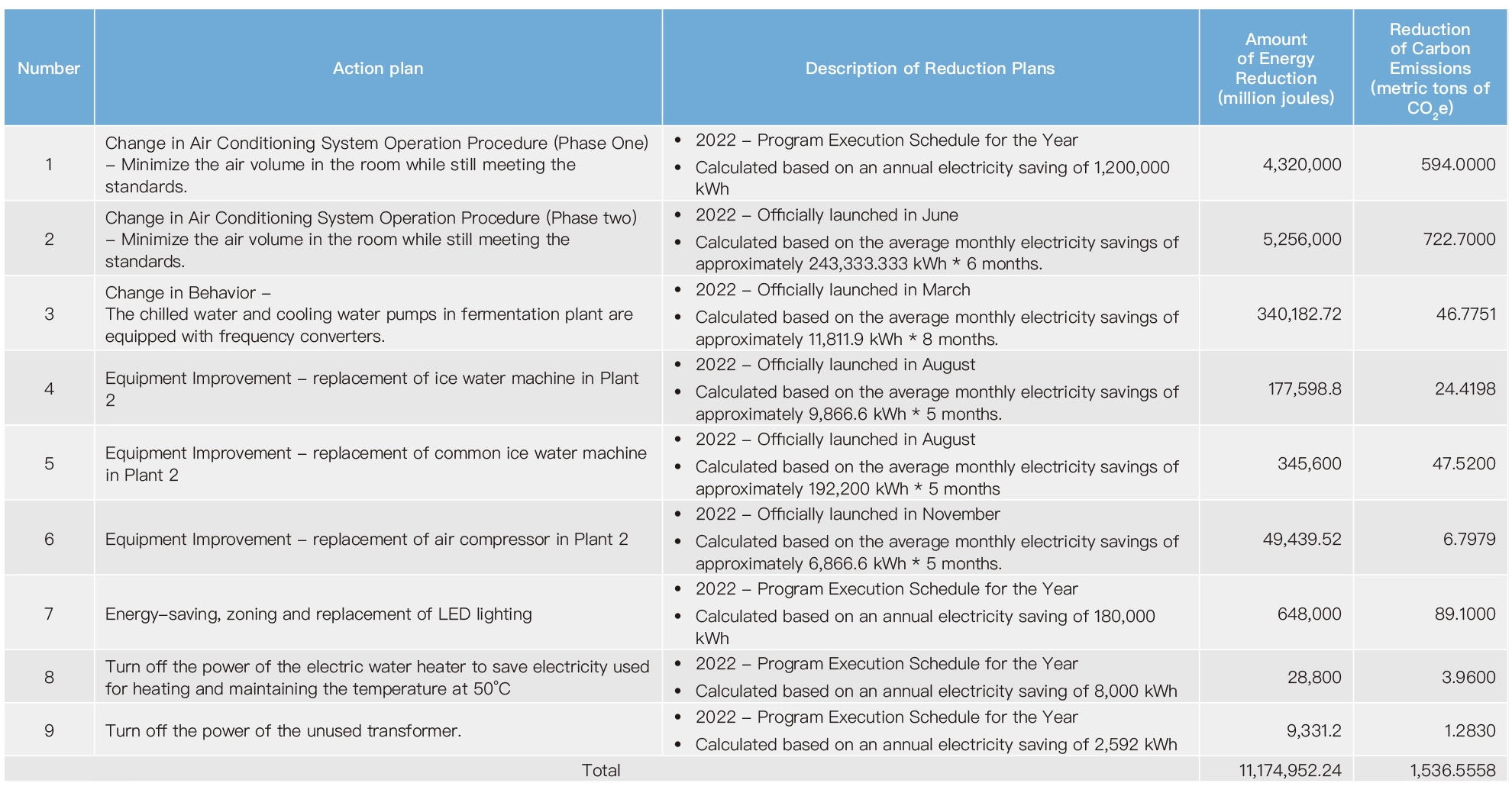Greenhouse Gas Emissions
Formosa Laboratories has been conducting greenhouse gas inventories in accordance with the ISO 14064-1:2018 standards since 2022. Furthermore, Formosa Laboratories conducts a greenhouse gas inventory each year, with 2022 as the base year, and passes the third-party verification process, in order to observe our carbon emission hotspots and reduction outcomes. In 2023, the total greenhouse gas emissions at Formosa Laboratories was 56,549.3102 metric tons of CO2 e. The increase in carbon emissions was mainly due to the procurement of equipment and instruments for plant expansion and the rise in overall electricity consumption. However, the Scope 1 and 2 greenhouse gas emission intensity was 8.16 metric tons of CO2 e per NT$ million, which was still lower than that in the previous year.
 Note:
Note:- Greenhouse gas emissions were compiled using the operational control method. With the entire area of Formosa Laboratories as the boundary (including Louchu Plant and Louchu No. 2 Plant), greenhouse gas inventories were conducted using the methodology stipulated in the ISO 14064-1:2018 standards. Only some of the items in Categories 3 and 4 were surveyed in the inventory of Scope 3 (Categories 3 to 6) greenhouse gas emissions.
- The data varied as the global warming potential (GWP) for each type of greenhouse gas was estimated using the GWP values in the IPCC Sixth Assessment Report, which were different from those in the IPCC Fourth Assessment report as adopted by the Ministry of Environment.
- The electricity carbon emission factors published by the Energy Administration were adopted in the data above, where the electricity carbon emission factors in 2022 and 2023 were 0.495 and 0.494 kg of CO2 e per kWh of electricity, respectively.
- Greenhouse gas emission intensity = Scope 1 and 2 greenhouse gas emissions (tons of CO2 e) per unit of revenue (NT$ million). The source of revenue data was Formosa Laboratories’ standalone financial statements, where Formosa Laboratories generated a revenue of NT$3,804.145 million in 2022 and NT$4,346.290 million in 2023, which were rounded to two decimal places.
- Formosa Laboratories was awarded the ISO 14064-1 Greenhouse Gas Verification Statement as the greenhouse gas inventory data for 2022 and 2023 were verified by thirdparty organization SGS Taiwan.
- Restatement of information: The 2022 data for greenhouse gas emission intensity was adjusted as a result of adjustments to the formula for calculating greenhouse gas emission intensity (which excluded Scope 3 greenhouse gas inventory data and involved the change of unit of denominator from NT$ thousand to NT$ million in revenue).
Energy Conservation and Carbon Reduction
In 2023, Formosa Laboratories continued to replace energy-consuming equipment, which was estimated to save 613,774 kWh of electricity and reduce up to 303.205 metric tons of CO e throughout the year. With the completion of the construction of Phase I solar power generation facility, 385,982 kWh of electricity were generated from July to December, which can ensure the continuation of our annual carbon reduction outcomes. In the future, we will also continue to implement electricity saving programs and promote environmental protection and green living in daily office activities. Furthermore, we will plan the construction of Phase II solar power generation facility in addition to assessing and purchasing renewable energy sources, with a view to reducing electricity consumption year by year, thereby achieving the goal of energy saving and carbon reduction.
 Note:
Note:- The energy conservation action plans listed in the table above primarily involve electricity saving, while the scope of carbon reduction covers Scope 2 greenhouse gas emissions.
- The amount of energy conserved was estimated based on the difference in the amount of electricity used before and after the implementation of each action plan, which was then converted into megajoules using the following formula: 1 kWh = 3.6 MJ.
- Reduction amounts were calculated based on the following formula: Amount of electricity saved (kWh) × Electricity carbon emission factor published by the Energy Administration, Ministry of Economic Affairs (0.494 kg of CO2e per kWh of electricity), which were rounded to three decimal places.
Greenhouse Gas Emissions
The Company initiated a greenhouse gas inventory in compliance with the Ministry of Environment's regulations in 2021. In 2022, the Company conducted a greenhouse gas inventory with the boundary of entire Formosa Laboratories (the Louchu Plant and Louchu Plant 2), using the methodology of GHG Protocol and the latest version of the international standard ISO 14064- 1:2018. The Company plans to commission a qualified third-party verification organization in 2023 to verify greenhouse gas emissions and obtain an ISO 14064-1 greenhouse gas verification statement. In the future, the Company will conduct annual greenhouse gas inventories and verifications, set specific reduction targets for greenhouse gases, and use 2022 as the base year for annual reduction progress reviews.
In 2022, the greenhouse gas emissions of Formosa Laboratories are as follows: Scope 1(Category 1) emissions are 7,744.8849 metric tons; Scope 2 (Category 2) emissions are 25,787.124 metric tons; Scope 3 (Category 3 to 6) emissions are 11,251.9124 metric tons, totaling 44,783.9213 metric tons. Due to the greenhouse gas inventory and calculation for the year 2022, which was conducted in accordance with international standards, the data is more complete than before 2021. No further explanations of the differences are provided to avoid distorting comparisons.
GHG Emissions of Formosa Laboratories in the Past Two Years
(unit: metric tons of CO2e)

- The greenhouse gas emissions are compiled using the operational control method, following the methodology of ISO 14064-1:2018 for inventory. The investigation of items in Scope 3 (Categories 3 to 6) is only conducted for certain items in Categories 3 and 4; however, the data for Scope 3 has not been investigated in 2021, and thus relevant information has not been included in the statistics.
- The GWP of each greenhouse gas is based on estimated values from the IPCC's Assessment Report 6 (AR6) that differ from the coefficient in the AR4 version reported to the Ministry of Environment. These differences lead to variations in the data.
- In 2021, the carbon emission coefficient for electricity is 0.509 tons CO2e/kWh. As for 2022, the carbon emission coefficient for electricity is 0.495 kg CO2e/kWh.
- GHG emission intensity calculation formula: Total GHG emissions (metric tons CO2e) / revenue (NT$ thousand).
Energy saving and Carbon Reduction
Formosa Laboratories currently employs multiple paperless management systems, which not only improve operational efficiency but also reduce paper waste. The initial implementation of the Business Process Management (BPM) system starts with procurement, followed by the relevant requirements from each department. Currently, most processes are online and nearing completion. This will approximately save 65,800 A4 papers annually. Agilent GC/LC's Product Analysis Reports can be attached directly to the LIMS (Lab Information Management System) as electronic files, eliminating the need for paper printing and saving approximately 268,500 A4 papers annually. The launch of the Document Management System (DMS) in 2023 is expected to save approximately 19,600 A4 papers annually.

2022 Formosa Laboratories Saving and Carbon Reduction Action Plan Performance

Note:
- All types of energy-saving listed are electricity; the scope of carbon reduction refers to Scope 2.
- The energy savings are calculated based on estimated electricity savings before and after implementing each action plan, taking into account the average monthly electricity savings and activation time. The electricity savings for 2022 will be estimated and then converted into million joules using a conversion factor of 1 kWh = 3.6 MJ.
- The carbon reduction is calculated based on the saved electricity consumption * the carbon emission coefficient of electricity. The emission coefficient used in the calculation is 0.495 kg CO2e/kWh, as announced by the Bureau of Energy, Ministry of Economic Affairs in 2022. The value has been rounded to the fourth decimal place.